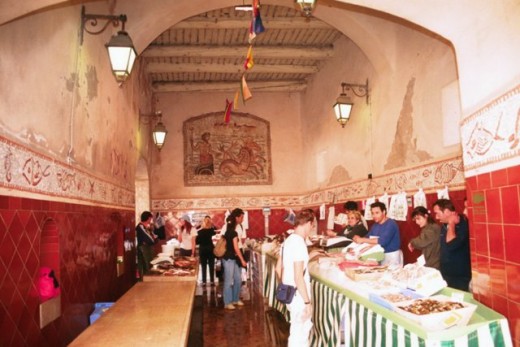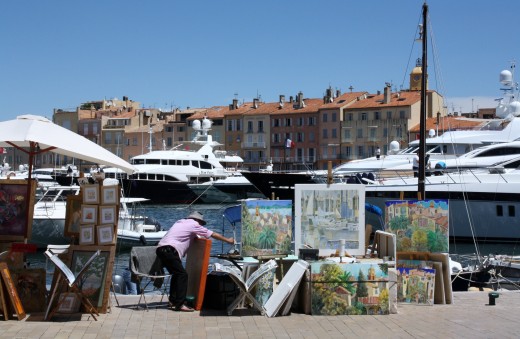The proud heritage of St. Tropez


It's more than a tan
May is my favorite time of the year to visit the Cote d’Azur. The weather is sunny, mild and magnificent, and two of my favorite events take place: for three days In the middle of the month, St. Tropez celebrates Les Bravades, originally a demonstration of defiance, a panoply of color, musket fire, pomp, ceremony and religion.
St. Tropez is best known for its summer of luminaries, star and starlets, musicians and a varied assortment of the rich and famous. Jetsetters anchor their yachts off shore or rent or buy a villa along the coast. But for most of the year, disregarding the yachts docked shoulder to shoulder in the port, St. Tropez is largely what it has always been: a sleepy fishing village with locals and the odd familiar face playing petanque in the park.





A dog, a cat and a saint on the beach
A couple thousand years ago, the coastal fishing village, known then as Heraclea, was subject to repeated raids, particularly by the Saracens, who wrought havoc all along the coastline. In the 16th century, Tropeziennes constructed the Citadel and appointed a Capitaine de Ville to organize the town’s defense. The original fort was destroyed at the end of the 16th and rebuilt in the 17th. Now boasting a naval museum, the fort continues to watch over the town and coastline. Its construction is directly related to Les Bravades.
Sometime after the first century, the town became known as St. Tropez, in honor of St. Torpes of Pisa, whose decapitated body, according to legend, washed up on shore here.
The story goes that St. Paul himself had converted St. Torpes, a centurion in Nero’s household, to Christianity. When he refused to recant as Nero demanded, the emperor ordered him beheaded. His head was thrown in the Arno and his body set adrift on a raft or leaky boat with a rooster and dog that were expected to nourish themselves on his body.
Yet, when a young Christian woman named Célèrine, who had a premonition, discovered Torpes on the beach, his body was intact and the rooster and dog headed off in different directions. Supporting this story, two nearby towns, Cogelin and Grimaud, are named after the rooster and dog, respectively, although Grimaud also has associations with the Grimaldi family, also prominent in St. Tropez history.
NEVER order a martini in Port Grimaud. Never.
St. Torpes busts out
St. Torpes also figures prominently in Les Bravades.
St. Tropez’s fortunes began to change at the turn of the previous century, when artist Paul Signac sailed to the village, where he found the quality of the light unique. Other artists such as Pierre Bonnard and Henri Matisse followed his lead and the town became a center for artists. Existentialist writers and film actors followed later, but it is the painters whose influence is still obvious in the daily exhibition of art for sale at the edge of the port.
My favorite memory of Les Bravades, which means the defiances or shows of bravado, is the first time I stumbled upon it. I had driven from Cannes to St-Trop, on May 16or 17, for more than 450 years, two of the three days devoted to Les Bravades. Although it was not my first visit to my favorite town, as I walked from the car park, I heard a haunting melody that seemed to come from nowhere and everywhere at once. I sought to track down the source of the music that echoed off the ancient building, but the narrow hillside streets made it elusive.
When I finally happened upon them, I was awed. As I approached a street, men in ancient military uniforms passed by playing flutes and drums, the St. Tropez hymn.
That day and over the passing years, I have enjoyed the spectacle of musketeers, and 16th century navy and militia men passing in review behind their patron saint, St. Torpes.
The origin of the Bravades is said to be in the 13th century, but in the middle of the 16th century, Tropeziennes named a captain of the city, to organize its defense against repeated raids from the sea. St. Tropez had once been an independent village, free from national taxes, and it was permitted to raise a standing army. In the middle of the 17th century, the local Tropezienne militia turned away a Spanish flotilla, cause for celebration indeed. But about the same time, Louis XIV revoked the city’s privilege. Irate citizens demonstrated, parading in the streets and firing their muskets in the air.
And that tradition has continued to the present.


Musketeers and gun smoke
Events begin on May 16, with a musket volley of 21 shots, followed by a parade into the town hall square, where city officials hand over the pike and flag, symbols of their authority, to the Capitaine de Ville and his lieutenant
The Brotherhood of the Bravades remove the bust of St. Torpes from the church and four crimson clad Pisans who have come expressly for the duty, carry him in a sedan chair leading the procession through the streets of St. Tropez.
At a series of designated stops along the five-hour parade route, the Pisans set down the bust and a young boy selected as the ensign performs a flag ceremony before it. The Brotherhood follows up with another series of musket shots that fill the town with gun smoke, at times making it difficult to see the person next to you. At the end of the demonstration, the Brotherhood return the bust to the church, where Trapeziennes in traditional Provencal clothes and carrying red and white flowers, will attend Mass and sing traditional songs the next morning.
Church, flowers, music, dancing
Later on the 17th, the Brotherhood will repeat the previous day’s celebration with the Grande Bravade, which features longer stops, more ceremony and extended musket fire.
On the third day, St. Torpes and his Pisan esc orts lead the townspeople in traditional clothes to the Chapel of Ste. Anne for an al fresco Mass and picnic before returning to town, dancing the traditional Farandole.
There are many reasons to go to St. Tropez, but for me, the mid-May Bravades will always be the main attraction.
- Les Bravades de Saint-Tropez - golfe-infos.com - YouTube
Vidéos des Bravades de Saint-Topez par golfe-infos.com le site du Golfe de Saint-Tropez. The sound is shrill, but it gives an idea of the St. Tropez hymn.











